A) zero
B) 0.44 kN/C
C) 57 N/C
D) 0.11 kN/C
E) 0.23 kN/C
Correct Answer

verified
Correct Answer
verified
Multiple Choice
A positively charged rod is brought near but not touching) the left side of an electrically neutral metal sphere. Which of the following statements is true about the sphere?
A) While the rod is near, the sphere becomes positively charged.
B) While the rod is near, the sphere becomes negatively charged.
C) While the rod is near, the right side of the sphere has a positive charge.
D) When the rod is removed, the sphere remains positively charged.
E) While the rod is near, the left side of the sphere has a positive charge.
Correct Answer

verified
Correct Answer
verified
Multiple Choice
563 × 10-12 m from the plutonium nucleus?
A) 4.27 × 1015 N
B) 3.85 × 10-14 N
C) 6.83 × 10-2 N
D) 6.42 N
E) 1.09 × 10-1 N
Correct Answer

verified
Correct Answer
verified
Multiple Choice
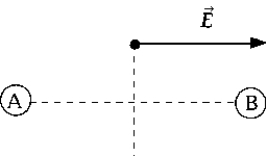 In the figure, the direction of the electric field at a point equidistant from two equally charged bodies A and B is indicated by a vector. The direction of the vector indicates that
In the figure, the direction of the electric field at a point equidistant from two equally charged bodies A and B is indicated by a vector. The direction of the vector indicates that
A) both A and B are positive.
B) both A and B are negative.
C) A is positive and B is negative.
D) B is positive and A is negative.
E) B is negative and A is neutral.
Correct Answer

verified
Correct Answer
verified
Multiple Choice
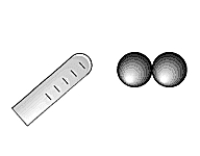 If you bring a negatively charged insulator near two uncharged metallic spheres that are in contact and then separate the spheres, the sphere on the right will have
If you bring a negatively charged insulator near two uncharged metallic spheres that are in contact and then separate the spheres, the sphere on the right will have
A) no net charge.
B) a positive charge.
C) a negative charge.
D) either a positive or negative charge.
E) None of these is correct.
Correct Answer

verified
Correct Answer
verified
Multiple Choice
For a uniformly charged spherical sphere of radius R carrying a total charge Q, calculate the electric field at a distance R/2 outside the sphere divided by the electric field at a distance R/2 inside the sphere.
A) 9/8
B) infinity
C) 4/9
D) 8.0
E) 8/9
Correct Answer

verified
Correct Answer
verified
Multiple Choice
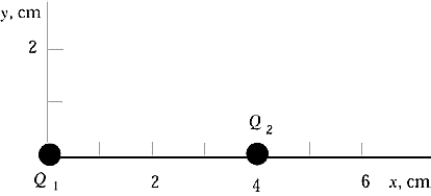 In the diagram, Q1 = 6.0 μC and Q2 = -6.0 μC. The electric field at point 2, 0) is
In the diagram, Q1 = 6.0 μC and Q2 = -6.0 μC. The electric field at point 2, 0) is
A) in the positive x direction.
B) in the negative x direction.
C) in the positive y direction.
D) in the negative y direction.
E) zero at this point.
Correct Answer

verified
Correct Answer
verified
Multiple Choice
An infinitely long cylinder of radius 4.0 cm carries a uniform volume charge density p = 200 nC/m3. What is the electric field at r = 4.1 cm?
A) zero
B) 0.11 kN/C
C) 57 N/C
D) 0.44 kN/C
E) 0.23 kN/C
Correct Answer

verified
Correct Answer
verified
Multiple Choice
 An infinite slab of thickness 2d lies in the xz-plane. The slab has a uniform volume charge density r. The electric field at y = b where b > d is
An infinite slab of thickness 2d lies in the xz-plane. The slab has a uniform volume charge density r. The electric field at y = b where b > d is
A) 2πkρ/d.
B) 4πkρ/d2.
C) 4πkρd.
D) 2πkρd.
E) 4πkρ/d.
Correct Answer

verified
Correct Answer
verified
Multiple Choice
Consider a uniform electric field E= 5.0 kN/C) parallel to the +x axis. What is the flux of this field through a square of side 20 cm if the normal to its plane makes a 45º angle with the x-axis?
A) 71 N · m2/C
B) 0.14 kN · m2/C
C) 0.28 kN · m2/C
D) 0.35 kN · m2/C
E) 0.19 kN · m2/C
Correct Answer

verified
Correct Answer
verified
Multiple Choice
The direction of the electric field at a point is the same as
A) the force on a neutron placed at that point.
B) the force on a proton placed at that point.
C) the force on an electron placed at that point.
D) the force on a hydrogen molecule placed at that point.
E) None of these is correct.
Correct Answer

verified
Correct Answer
verified
Multiple Choice
Three charges are located at 100-m intervals along a horizontal line: a charge of -3.0 C on the left, +2.0 C in the middle, and +1.0 C on the right. What is the resultant force on the 1.0 C charge due to the other two?
A) 1.1 × 106 N to the right
B) 1.1 × 106 N to the left
C) 2.5 × 106 N to the right
D) 2.5 × 106 N to the left
E) 4.5 × 107 N to the right
Correct Answer

verified
Correct Answer
verified
Multiple Choice
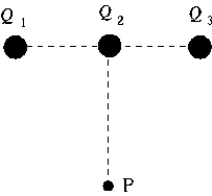 Three charges Q1, Q2, and Q3, each equal to 6.4 × 10-19 C, are in a straight line. The distance between neighboring charges is 60 nm. The magnitude of the electric field at P, which is 80 nm from Q2 on a line at right angles to the line between Q1 and Q3, is
Three charges Q1, Q2, and Q3, each equal to 6.4 × 10-19 C, are in a straight line. The distance between neighboring charges is 60 nm. The magnitude of the electric field at P, which is 80 nm from Q2 on a line at right angles to the line between Q1 and Q3, is
A) 1.2 × 10-8 N/C.
B) 16 N/C.
C) 2.0 N/C.
D) 1.9 × 1010 N/C.
E) 1.2 × 108 N/C.
Correct Answer

verified
Correct Answer
verified
Multiple Choice
00 × 106 N/C. The resulting change in the acceleration of the oil droplet is approximately
A) 1.76 × 1017 m/s2.
B) 16.0 m/s2.
C) 1.60 m/s2.
D) 1.76 × 1018 m/s2.
E) 176 m/s2.
Correct Answer

verified
Correct Answer
verified
Multiple Choice
Two point charges of unknown magnitude and sign are a distance d apart. If the electric field strength is zero at a point between them on the line joining them, you can conclude that
A) the charges are equal in magnitude but opposite in sign.
B) the charges are equal in magnitude and have the same sign.
C) the charges are not necessarily equal in magnitude but have opposite signs.
D) the charges are not necessarily equal in magnitude but have the same sign.
E) there is not enough information to say anything specific about the charges.
Correct Answer

verified
Correct Answer
verified
Multiple Choice
Which of the following statements is not true?
A) In nature, electric charge is conserved.
B) The force of repulsion between two like charges is directly proportional to the product of the square of the charges.
C) The force of repulsion between two like charges is inversely proportional to the square of the distance separating the charges.
D) Unlike charges attract each other.
E) Like charges repel each other.
Correct Answer

verified
Correct Answer
verified
Multiple Choice
Protons
A) are about 2000 times more massive than electrons.
B) are about 2000 times less massive than electrons.
C) have 2000 times the charge of electrons.
D) have 1/2000 the charge of electrons.
E) can have any amount of charge.
Correct Answer

verified
Correct Answer
verified
Multiple Choice
Two positive charges +8.0 mC and +2.0 mC) are separated by 300 m. A third charge is placed at distance r from the +8.0 mC charge in such a way that the resultant electric force on the third charge due to the other two charges is zero. The distance r is
A) 0.25 km.
B) 0.20 km.
C) 0.15 km.
D) 0.13 km.
E) 0.10 km.
Correct Answer

verified
Correct Answer
verified
Multiple Choice
Which of the following statements about electric field lines are true?
A) The lines are drawn symmetrically entering or leaving an isolated charge.
B) At large distances from a system of charges, the field lines are equally spaced and radial, as if they came from a single point charge equal to the net charge of the system.
C) Electric field lines begin on positive charges or at infinity) and end on negative charges or at infinity) .
D) The number of lines leaving a positive charge or entering a negative charge is proportional to the charge.
E) All of these statements are true.
Correct Answer

verified
Correct Answer
verified
Multiple Choice
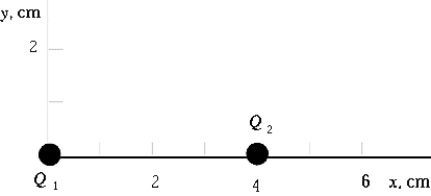 In the diagram, Q1 = 6.0 μC and Q2 = -6.0 μC. If Q2 has a mass of 2.0 g, a uniform electric field of 1.5 kN/C imposed in the positive y direction would give this particle an acceleration in the y direction of approximately
In the diagram, Q1 = 6.0 μC and Q2 = -6.0 μC. If Q2 has a mass of 2.0 g, a uniform electric field of 1.5 kN/C imposed in the positive y direction would give this particle an acceleration in the y direction of approximately
A) zero.
B) 9.0 mm/s2.
C) 22 cm/s2.
D) 4.5 m/s2.
E) 7.5 × 105 m/s2.
Correct Answer

verified
Correct Answer
verified
Showing 21 - 40 of 131
Related Exams